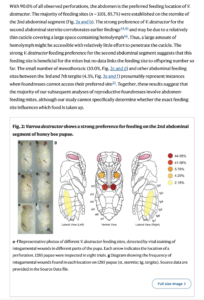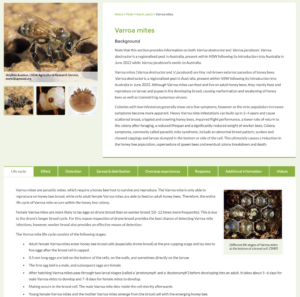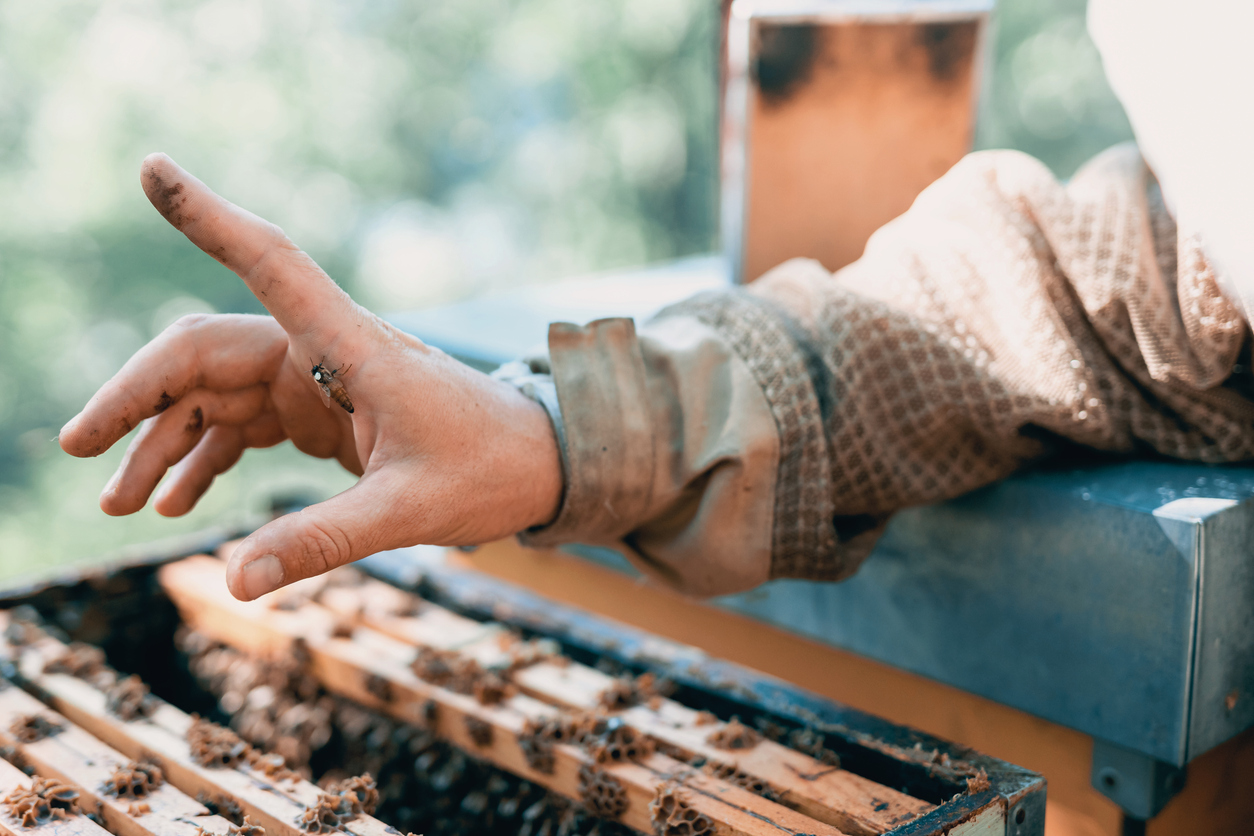Diseases and pests can significantly hinder honeybees and the work they contribute to. It’s important to know about honeybee diseases and pests, and how to prevent them.
Common Honeybee Diseases and Pests
Here are some common honeybee diseases and pests:
Varroa Mites
Varroa mites are one of the most destructive honey bee pests. They are small red/brown external parasites that feed on both the fat bodies and haemolymph of honeybees at different stages of their life cycle (source). This significantly weakens honeybees and allows mites to act as a vector for various viruses. It is actually the viruses, rather than the mites themselves, that cause the most damage to honeybees when mites are present in the hive (source). The transmission of viruses, often multiple viruses at once, through varroa mites eventually breaks down the colony by crippling and deforming bees, thereby disrupting their behavior.
One notable virus transmitted by varroa mites is Deformed Wing Virus (DWV), which causes deformed wings and shortened abdomens in adult honeybees. The virus is associated with reduced lifespan, patchy brood, and reduced colony populations (source).
Generic symptoms of varroa infestation can include spotty brood pattern, adult bees that are crippled or with deformed wings, pupae uncapped prematurely, unexplainable reduction in colony population, and visible mites seen crawling (source). However, symptoms can vary widely depending on a number of variables.
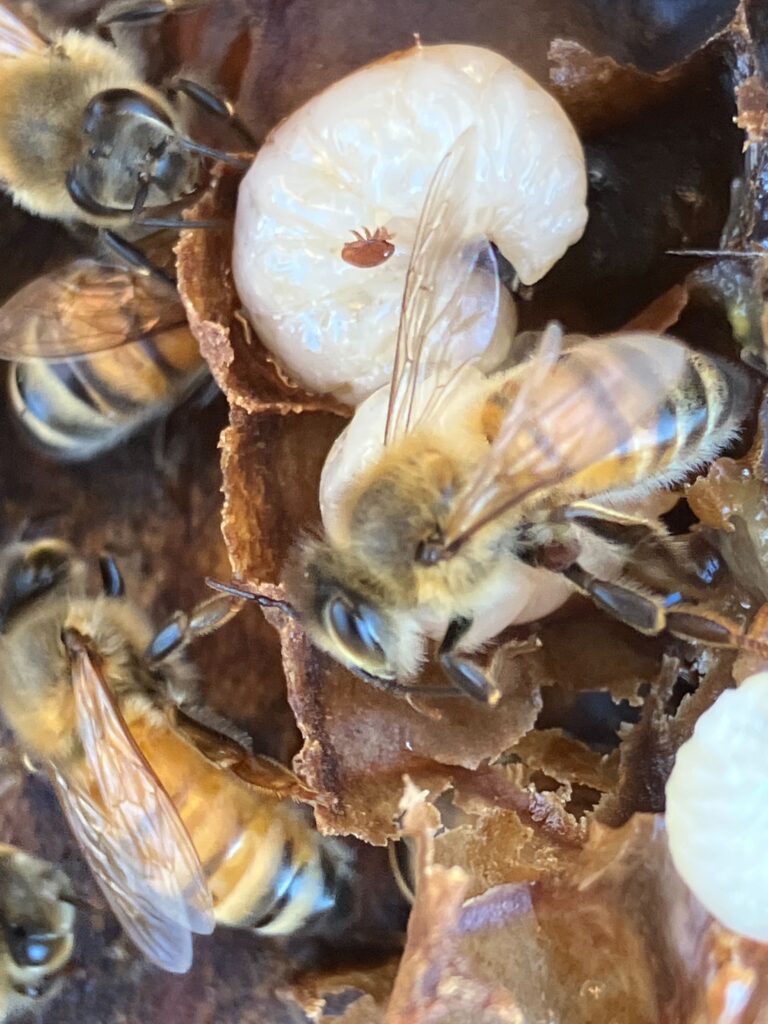
Nosema
Nosema is a fungal disease that affects the digestive tract of adult honeybees. Bees become infected when they ingest food or water contaminated with spores of the fungus which then germinate in their midgut. One single spore of the fungus can cause the infection! These spores can survive in the environment for extended periods, making it difficult to eradicate the infection.
General colony symptoms include a weakened colony buildup, especially during the spring, reduced honey production, and dysentery. In severe cases, infected bees may have swollen and greasy looking abdomens.
Nosema can shorten infected bees’ lifespan and weaken a colony’s overall performance. Infected bees are less effective in their roles within the hive, leading to a decline in brood care, foraging, and honey production.
American Foulbrood and European Foulbrood
American Foulbrood (AFB) and European Foulbrood (EFB) are both diseases that affect the honeybee larvae. Despite their names, both AFB and EFB are found globally, and can quickly spread between hives.
AFB, caused by the spore-forming bacterium Paenibacillus larvae, is considered the most deadly bacterial honeybee disease due to its rapid spread and limited treatment options available.
American Foulbrood (AFB) exhibits distinct symptoms in brood, including:
- Irregular brood patterns
- Visibly affected cell cappings, which may appear sunken, dark, or greasy due to decomposing larvae.
- Perforated cappings from bees attempting to remove dead brood
- Sulphurous odor
AFB can be transmitted through contaminated equipment, as well as drifting bees. Learn how Dalan’s AFB vaccine can help to prevent clinical infection in your hives.
EFB, caused by the bacterium Melissococcus plutonius, is not as severe as AFB because the bacterium does not produce spores, which remain persistent in the environment, spreading through contaminated equipment, bees, or hive products. However, the disease can still be devastating for hives.
Detecting EFB is difficult because the symptoms are similar to other hive health issues. Symptoms may include irregular brood pattern, larvae that are curled, yellow to brown, and uncapped, and slightly sour smell. It is best to use a diagnostic kit to correctly diagnose clinical EFB.
AFB
EFB
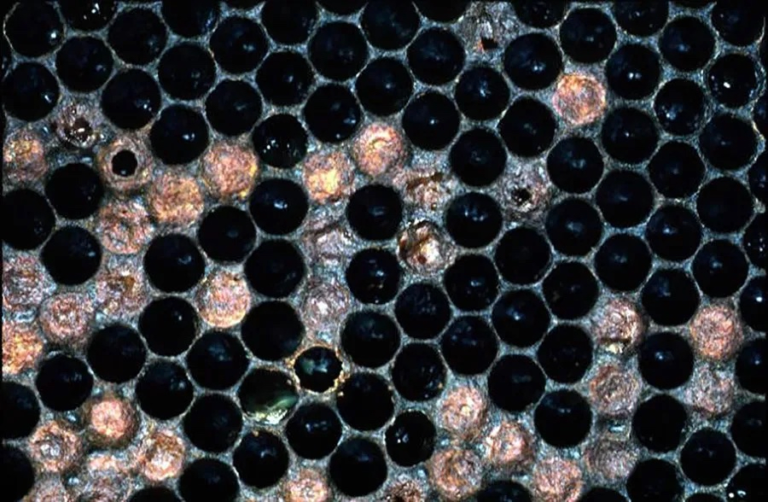

Image Source: Backyard Beekeeping
Small Hive Beetles
Small hive beetles (SHB) are scavenger beetles, with a distinctive oblong body and club-like antennae. They are considered to be a secondary pest, causing the most damage to colonies that are already weak. SHB are attracted to hives by the smell of honey and pollen, and once inside the hive can damage comb, stored honey, and pollen – leading to severe consequences.
Symptoms and signs of SHB include fermentation of the hive products (pollen, nectar, brood) which leads to slimy equipment, a key characteristic of the infestation. You may also spot SHB larvae, which look like small maggots, wiggling around. The impacts of SHB can be devastating for honey production, as the beetle larvae’s defecation leads to the fermentation and spoiling of honey, rendering it unusable.
Transmission is mainly achieved through flight as adult SHBs can fly up to 10 kilometres, enabling them to infest neighboring colonies. The best method for prevention is to maintain healthy colonies in well-kept equipment, ensuring that the apiary is clean and free from old equipment and dead-outs.
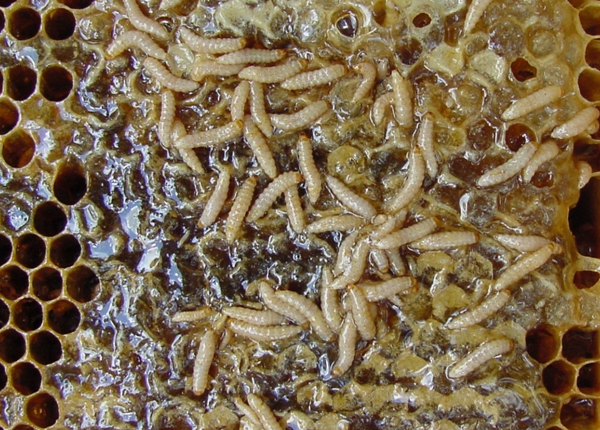
Slimy appearance caused by SHB infestation.
Image Source: Bee Health
Preventative Measures and Best Practices
Here are some preventative measures to avoid honeybee diseases and pests:
Monitoring
Hive inspections are essential in beekeeping to effectively manage your colony’s health. Regular inspections of hives should be conducted at least once every two weeks to detect early signs of diseases and pests. Your local apiary inspectors and honeybee veterinarians can be a great resource to help you identify diseases and provide treatment solutions.
Hive Hygiene
Clean your equipment to prevent cross-contamination and refrain from leaving old equipment in your apiary, which can harbor pests and disease. Scorch hive tools with a torch to remove wax and pathogens.
Pest Management Strategies
You can use chemical treatments, microbial treatments, or drone brood removal to control varroa mites. Remember to always monitor before and after treatments to evaluate their effectiveness.
Dalan’s Solution to Honeybee Disease
Preventing disease is significantly less expensive than treating disease. Vaccination is an effective and safe way to prevent and control the spread of infectious diseases that cause high morbidity and mortality in a population. Dalan’s AFB vaccine, containing pieces of killed P. larvae, is fed to the honey bee queen, and immunity is passed on to her progeny. It is free of chemicals, preservatives and is non-GMO.
Learn more about how you can help prevent honeybee diseases and pests by contacting Dalan today.
Additional Resources

Why Vaccinate Your Honey Bees for AFB?
 This whitepaper speaks to how vaccination can be a promising alternative to protect honey bee colonies and the food supply chain.
This whitepaper speaks to how vaccination can be a promising alternative to protect honey bee colonies and the food supply chain.Transgenerational Immune Priming
 This whitepaper is on the topic of: How insects pass immunity to their offspring.
This whitepaper is on the topic of: How insects pass immunity to their offspring.Product Brochure
 Download our brochure to discover more about Dalan Animal Health’s AFB Vaccine, its benefits, and how it works.
Download our brochure to discover more about Dalan Animal Health’s AFB Vaccine, its benefits, and how it works.
